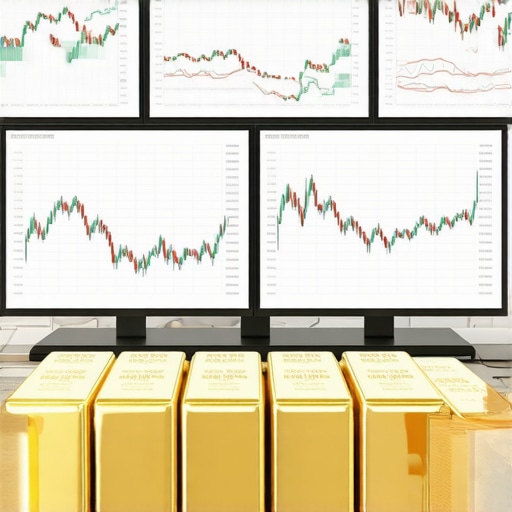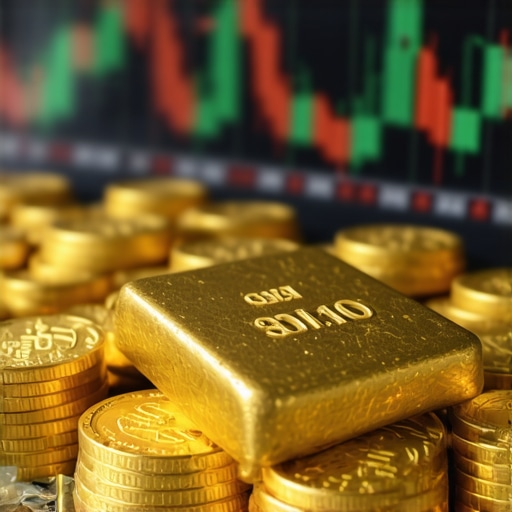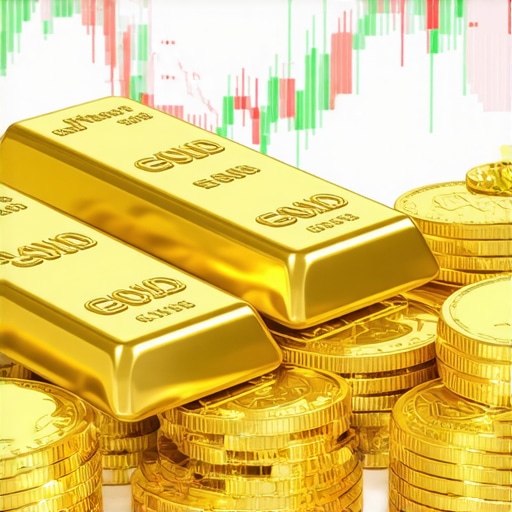Understanding the Gold Market: Key Factors Impacting Price Dynamics in 2025
The gold market is a complex ecosystem influenced by various factors that can significantly affect the price of this precious metal. As we move into 2025, investors need to stay informed about the key dynamics shaping gold prices. Understanding these elements is crucial for making informed investment decisions, whether you are considering gold demand trends, price forecasts, or exploring other investment opportunities.
Several key factors influence gold price dynamics, including economic indicators, geopolitical tensions, and market sentiment. Each of these elements plays a pivotal role in determining how gold prices fluctuate over time.
Economic Indicators: The Backbone of Gold Prices
Economic indicators such as inflation rates, interest rates, and GDP growth are fundamental to understanding gold price movements. For instance, when inflation rises, investors often flock to gold as a hedge against currency devaluation. In contrast, when interest rates increase, the opportunity cost of holding non-yielding assets like gold rises, which can lead to a drop in demand.
In 2025, monitoring these economic indicators will be critical. Investors should pay close attention to reports from central banks and evaluate their impact on gold prices. For example, central bank policies can create ripple effects across global markets, influencing everything from gold price fluctuations to investor confidence.
Geopolitical Tensions and Their Impact on Gold Investment
Geopolitical events often create uncertainty, leading to increased demand for gold as a safe-haven asset. Conflicts, trade wars, and political instability can prompt investors to turn to gold, driving prices higher. As we look ahead to 2025, the geopolitical landscape will undoubtedly continue to evolve, and investors must stay vigilant.
For instance, tensions in key regions or changes in government policies can have immediate effects on gold prices. Keeping an eye on these developments can help investors make timely decisions. Additionally, analyzing gold market trends in relation to geopolitical events will provide deeper insights into potential price movements.
Market Sentiment: The Emotional Aspect of Gold Trading
Market sentiment plays a crucial role in gold price dynamics. Investor psychology can lead to rapid price changes, often unrelated to fundamental factors. In 2025, it will be essential to gauge market sentiment through various indicators, including the gold investment analysis and trends in trading volumes.
Understanding how investors feel about the economy and gold’s role within it can guide strategic investment decisions. For instance, if sentiment is overly bullish, prices may be driven up unsustainably, leading to potential corrections in the future.
In conclusion, as we prepare for 2025, being aware of the key factors influencing gold price dynamics will be crucial for investors. By analyzing economic indicators, geopolitical tensions, and market sentiment, one can better navigate the complexities of the gold market and make informed investment choices.
Investor Behavior: Understanding Trends and Patterns
Investor behavior significantly impacts gold price dynamics, particularly as we approach 2025. Behavioral economics shows that decisions are often driven by emotions rather than logic, leading to trends that can affect the gold market. For instance, during times of economic uncertainty, a surge in retail gold purchases can signal a shift in market sentiment. Investors looking to make informed decisions should analyze demand trends and how they correlate with external market factors.
The Role of Institutional Investors
Institutional investors, such as hedge funds and pension funds, play a pivotal role in shaping gold prices. Their strategies often involve large-scale buying or selling, which can create significant price movements. As we progress through 2025, keeping an eye on the activities of these large investors will be crucial. Reports on their gold holdings and investment strategies can provide insights into future trends.
For more detailed information about how institutional behaviors affect pricing, refer to our analysis on gold market trends. Understanding these patterns can help individual investors align their strategies with broader market movements.
Technological Advancements: Impact on Gold Trading
Technological advancements are revolutionizing the gold trading landscape. Online trading platforms and mobile applications have made it easier for investors to buy, sell, and monitor gold prices in real time. In 2025, the integration of artificial intelligence and big data analytics will provide traders with enhanced tools for predicting market trends.
Investors should also consider the impact of blockchain technology on gold trading. This technology enhances transparency and security, making physical gold investments more appealing. To learn how these innovations can influence your investment strategy, check out our comprehensive guide on choosing the right gold investment strategy.
Environmental and Ethical Considerations in Gold Mining
As concerns about sustainability grow, the environmental impact of gold mining is becoming a significant factor in investment decisions. Investors increasingly favor companies that adhere to ethical mining practices. In 2025, understanding the environmental, social, and governance (ESG) criteria will be essential for assessing gold investments.
Companies with strong ESG practices may see increased investment flows, potentially driving up their stock prices and the overall gold market. For insights on how to evaluate gold mining stocks based on ethical practices, refer to our post on investing in gold mining stocks.
Global Economic Policies: Effects on Gold Prices
Global economic policies, such as trade agreements and tariffs, can also influence gold prices. For instance, a weakening dollar typically boosts gold prices, as gold becomes cheaper for foreign investors. In 2025, monitoring changes in global trade dynamics will be vital for understanding potential price shifts.
Moreover, central bank policies, particularly those related to interest rates and inflation targeting, will continue to impact gold’s appeal as a safe-haven asset. Investors should stay informed about central bank meetings and economic forecasts to navigate these changes effectively. For further reading on central banks’ influence on gold prices, visit our analysis on central bank gold purchases.
Global Economic Policies: Effects on Gold Prices
Global economic policies, such as trade agreements and tariffs, can also influence gold prices. For instance, a weakening dollar typically boosts gold prices, as gold becomes cheaper for foreign investors. In 2025, monitoring changes in global trade dynamics will be vital for understanding potential price shifts.
Moreover, central bank policies, particularly those related to interest rates and inflation targeting, will continue to impact gold’s appeal as a safe-haven asset. Investors should stay informed about central bank meetings and economic forecasts to navigate these changes effectively. For further reading on central banks’ influence on gold prices, visit our analysis on central bank gold purchases.
The Role of Inflation in Gold Investment Strategy
Inflation is a critical factor that often drives investors toward gold. As the purchasing power of currency declines, gold is seen as a hedge against inflation. In 2025, as inflationary pressures may rise in various economies, understanding how to position your investments in gold will be essential. This involves not only buying physical gold but also considering gold-related assets like gold ETFs or mining stocks.
Trade Wars and Their Influence on Gold Prices
Trade wars can create significant volatility in global markets, often leading to increased demand for gold. For example, tariffs imposed on key commodities can lead to economic slowdowns, prompting investors to seek safe-haven assets like gold. In 2025, keeping an eye on international relations and trade agreements will provide valuable insights into potential shifts in gold demand.
Understanding how trade tensions influence economic stability can help you make more informed decisions about your gold investments. For those interested in exploring the impact of gold futures as a trading strategy amidst trade uncertainties, further resources are available.
Investor Psychology: How Emotions Drive Gold Prices
Investor psychology is a powerful force in the gold market. Emotions such as fear and greed can lead to irrational buying or selling, impacting gold prices. In 2025, paying attention to how investor sentiment shifts in response to economic news will be crucial. Various measures, such as the gold investment analysis, can help gauge market sentiment and guide your investment decisions.
For example, during periods of economic uncertainty, if investors perceive a high risk of recession, they may flock to gold, driving up its price. Conversely, a strong economic outlook can lead to decreased interest in gold as a safe haven. Understanding these psychological trends can provide a competitive edge in your investment strategy.
Retail vs. Institutional Investors: Diverging Strategies
The strategies of retail and institutional investors can differ significantly in the gold market. While retail investors may react quickly to news and market sentiment, institutional investors often take a more measured approach. Monitoring the activities of institutional investors can provide insights into broader market trends. For a deeper understanding of how institutional behaviors affect pricing, refer to our analysis on gold market trends.
As we move further into 2025, staying informed about the strategies employed by both retail and institutional investors will be essential for navigating the complexities of the gold market. Understanding these dynamics can help you align your investment decisions with prevailing market trends.
The Future of Gold: Emerging Trends and Predictions
Looking ahead, the gold market is poised for evolution. Emerging trends such as the increasing popularity of digital gold and the rise of sustainable investing are shaping the future landscape of gold investments. In 2025, investors should consider how these trends will influence their strategies. For instance, digital platforms that allow for fractional ownership of gold may attract a new generation of investors.
Moreover, as sustainability becomes a priority for many investors, those who prioritize ethical mining practices will likely see increased support. Understanding these emerging trends can help you position your investments effectively in the changing gold market landscape.
Emerging Technologies Influencing Gold Trading Practices
As we advance into 2025, technology continues to redefine how investors engage with the gold market. Innovations such as blockchain and artificial intelligence are not just buzzwords; they are reshaping trading practices and enhancing the efficiency of transactions. Blockchain technology, in particular, offers a transparent and secure method for tracking gold ownership, making it easier for investors to verify the authenticity of their assets.
For those interested in understanding how these technological advancements can enhance your investment strategy, explore our detailed guide on choosing the right gold investment strategy. By leveraging these tools, investors can make more informed decisions, ultimately improving their returns.
The Impact of Digital Gold on Investment Strategies
Digital gold has gained traction as a viable investment option, allowing individuals to buy and trade gold in a digital format without the need for physical storage. This shift caters to a tech-savvy generation that values convenience and accessibility. In 2025, the rise of digital platforms may lead to increased participation in the gold market, especially among younger investors.
Understanding how to integrate digital gold into your portfolio can provide diversification and flexibility. If you want to learn more about the benefits of investing in gold through digital means, check out our post on investing in gold.
Ethical Investing: The Growing Importance of Sustainability
As awareness of environmental and social issues grows, ethical investing is becoming a significant consideration for gold investors. In 2025, investors are likely to prioritize companies that demonstrate responsible mining practices and contribute positively to their communities. This focus on sustainability not only aligns with personal values but may also enhance long-term investment returns.
To navigate this evolving landscape, it’s crucial to stay informed about which gold mining companies adhere to strong environmental, social, and governance (ESG) standards. For insights on evaluating gold mining stocks based on ethical practices, refer to our article on investing in gold mining stocks. By aligning your investments with sustainable practices, you can contribute to a more responsible gold market.
The Role of Regulatory Changes in Gold Investment
Regulatory changes can significantly impact gold investments, influencing everything from mining operations to trading practices. In 2025, keeping abreast of new regulations will be vital for investors looking to navigate the complexities of the gold market. Changes in tax policies related to gold investments or adjustments in trade tariffs can create both challenges and opportunities.
Investors should stay updated on regulatory trends to anticipate how they may affect gold prices and investment strategies. For a comprehensive overview of how global economic policies influence the gold market, check out our analysis on central bank gold purchases.
Preparing for Market Volatility: Strategies for Investors
Market volatility is an inherent part of investing, particularly in precious metals like gold. As we approach 2025, developing strategies to manage risks associated with price fluctuations will be essential. Diversification, for example, can mitigate risks by spreading investments across various assets, including gold, stocks, and bonds.
Additionally, understanding market cycles and being prepared for downturns can give you a competitive advantage. To learn effective strategies for handling market volatility, refer to our guide on gold trading practices. By equipping yourself with knowledge and resources, you can navigate market uncertainties more effectively.
Comprehensive FAQ Section: Your Gold Investment Questions Answered
What factors influence gold prices in 2025?
Gold prices in 2025 will be influenced by economic indicators like inflation and interest rates, geopolitical tensions, market sentiment, and investor behavior. Keeping an eye on these factors can help investors make informed decisions.
How can I hedge against inflation with gold?
Gold is traditionally viewed as a hedge against inflation. As inflation rises, the purchasing power of currency declines, making gold a more attractive investment. Investors can consider purchasing physical gold, gold ETFs, or gold mining stocks to maintain value during inflationary periods.
What role do central banks play in the gold market?
Central banks significantly influence the gold market through their policies on interest rates and gold reserves. Their buying or selling activities can lead to substantial price movements, making it crucial for investors to monitor central bank decisions and reports.
How does geopolitical risk affect gold investments?
Geopolitical risks, such as conflicts and trade wars, often drive investors towards gold as a safe haven. Increased demand during uncertain times typically results in rising gold prices, highlighting the importance of staying informed about global events.
What is digital gold, and how does it differ from physical gold?
Digital gold allows investors to buy and trade gold in a digital format, eliminating the need for physical storage. This option is becoming popular among tech-savvy investors, offering convenience and liquidity compared to traditional gold investments.
How can I assess the ethical implications of gold mining?
To assess the ethical implications of gold mining, investors should focus on companies that adhere to strong environmental, social, and governance (ESG) standards. Researching a company’s practices and certifications can provide insights into their commitment to sustainable mining.
Is investing in gold mining stocks a good strategy?
Investing in gold mining stocks can be a good strategy, especially during periods of rising gold prices. These stocks can offer leveraged exposure to gold prices, but investors should also consider the inherent risks associated with mining operations.
What are the best strategies for navigating gold market volatility?
Diversification, staying informed about market trends, and developing a clear investment strategy can help investors navigate gold market volatility. Regularly reviewing and adjusting your portfolio in response to market changes will also be beneficial.
Why is market sentiment important in gold trading?
Market sentiment reflects the overall mood of investors toward gold and can drive price movements independent of fundamental factors. Understanding sentiment can help investors anticipate potential price changes and adjust their strategies accordingly.
Authority Resources: Trusted Sources for Gold Investment Insights
For those looking to deepen their understanding of the gold market and investment strategies, the following resources offer valuable insights:
- World Gold Council – A leading authority on gold market trends, providing research and insights on gold demand, supply, and investment.
- Investopedia – A comprehensive resource for investment education, including articles and tutorials on gold trading and market dynamics.
- Kitco News – A prominent source for real-time market data and analysis on gold and precious metals.
- Bloomberg Markets – Offers in-depth financial news and analysis, including updates on commodities like gold.
- CNBC – Provides market news and insights, covering gold prices and economic factors affecting the gold market.
Conclusion: Embracing the Future of Gold Investments
As we approach 2025, understanding the dynamics of the gold market is essential for investors looking to navigate potential challenges and opportunities. By analyzing economic indicators, geopolitical tensions, market sentiment, and emerging technologies, investors can develop informed strategies that align with their financial goals. With the growing importance of ethical investing and digital gold, the landscape of gold investments is shifting, offering fresh avenues for diversification and value preservation. Ultimately, staying informed and adaptable will be key to successfully navigating the complexities of the gold market in the years to come.










The analysis of gold price dynamics in 2025 here really highlights the multifaceted nature of the market. I’ve personally noticed that inflation trends, especially with current global economic uncertainties, are driving many investors to reconsider gold as a stable hedge. What stands out to me is the growing influence of technological advancements like blockchain, which not only increase transparency but also democratize access to gold investments through digital gold platforms. This could significantly alter traditional buying behavior, especially among younger investors who prefer digital convenience. Furthermore, the emphasis on ethical mining practices is timely; as environmental and social governance standards gain importance, I believe investors will increasingly prioritize companies aligned with sustainable practices, which may also impact prices. Institutional investor behavior remains a critical factor too; their large-scale movements can sway the market dramatically, and understanding their strategies can provide valuable insight for individual investors. Overall, integrating economic indicators with technology and ethical considerations provides a comprehensive approach to navigating gold investments in the coming year.
Building on Brenda’s insightful points about technology and ethical considerations in gold investing, I’d also highlight the importance of understanding market sentiment in 2025. From my experience, investor psychology often drives sharp gold price movements independent of fundamental economic data. For example, during recent geopolitical tensions, I’ve seen a surge in retail investor interest in gold that seems more emotion-driven than based on economic forecasts. This underscores the post’s point about the emotional aspect of gold trading, which can lead to potentially unsustainable price spikes.
Additionally, the role of institutional investors cannot be overstated. Their large trades can trigger rapid price changes, and tracking their reported holdings has helped me anticipate market shifts. It makes me wonder, though, how individual investors can better access timely data on institutional investor behavior to make more informed decisions.
How do others factor market sentiment and institutional movements into their gold investment strategies? Are there tools or indicators that have proven particularly useful for you in navigating this complex dynamic? It seems that combining economic indicators with sentiment analysis and institutional activity could create a more holistic approach to anticipating gold price fluctuations in the coming year.
Your post offers a comprehensive outlook on the key factors impacting gold prices in 2025. I agree that economic indicators like inflation and interest rates will remain critical, especially as central banks respond to ongoing global uncertainties. One aspect I’ve been observing is the increasing influence of technological innovation, especially blockchain, which you touched on briefly. It’s fascinating to see how this not only improves transparency but also broadens access to gold investments via digital platforms, making it more appealing to younger, tech-savvy investors.
Another point worth considering is how consumer behavior might shift with the rise of digital gold and ESG-friendly mining companies. I’ve noticed a growing trend where investors prioritize companies committed to sustainability, which could drive up demand for ethically mined gold. Do you think this will be a major driver alongside traditional economic factors?
Also, with the development of more sophisticated sentiment analysis tools, how do you see individual investors leveraging these to stay ahead of market swings caused by collective psychology? I believe combining market sentiment insights with macroeconomic data will be key in navigating the volatile landscape ahead.